Management Report: Comparing Corporate Cultures in The Circle
VerifiedAdded on 2022/12/29
|5
|1147
|85
Report
AI Summary
This report examines the corporate cultures of three distinct organizations: The Circle, a fictional tech company; Disneyland, a real-world entertainment giant; and Netflix, a modern streaming service. The analysis delves into the artifacts, values, and underlying assumptions that define each company's culture. The Circle's culture, characterized by transparency and surveillance, is contrasted with Disneyland's focus on customer experience and traditional values. The report also highlights the different control systems employed by each company, with The Circle and Disney exhibiting centralized control, while Netflix embraces a decentralized, team-based approach. The report concludes by recommending improvements to corporate cultures, emphasizing the importance of employee well-being and work-life balance as key drivers of long-term success. It also touches on the motivational aspects of each organization's culture, including the short-term effectiveness of manipulative tactics and the long-term benefits of fostering employee ownership and autonomy.
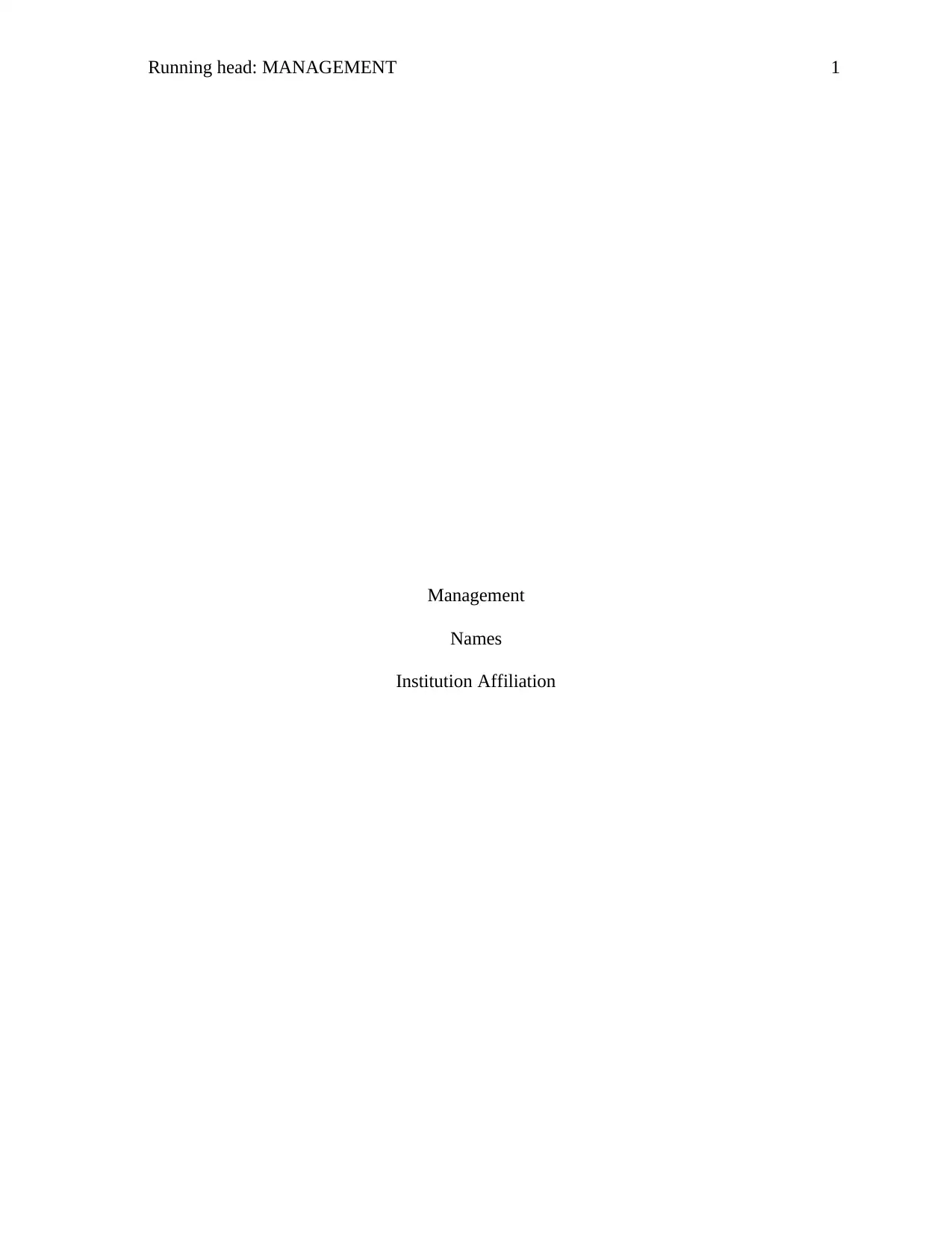
Running head: MANAGEMENT 1
Management
Names
Institution Affiliation
Management
Names
Institution Affiliation
Paraphrase This Document
Need a fresh take? Get an instant paraphrase of this document with our AI Paraphraser
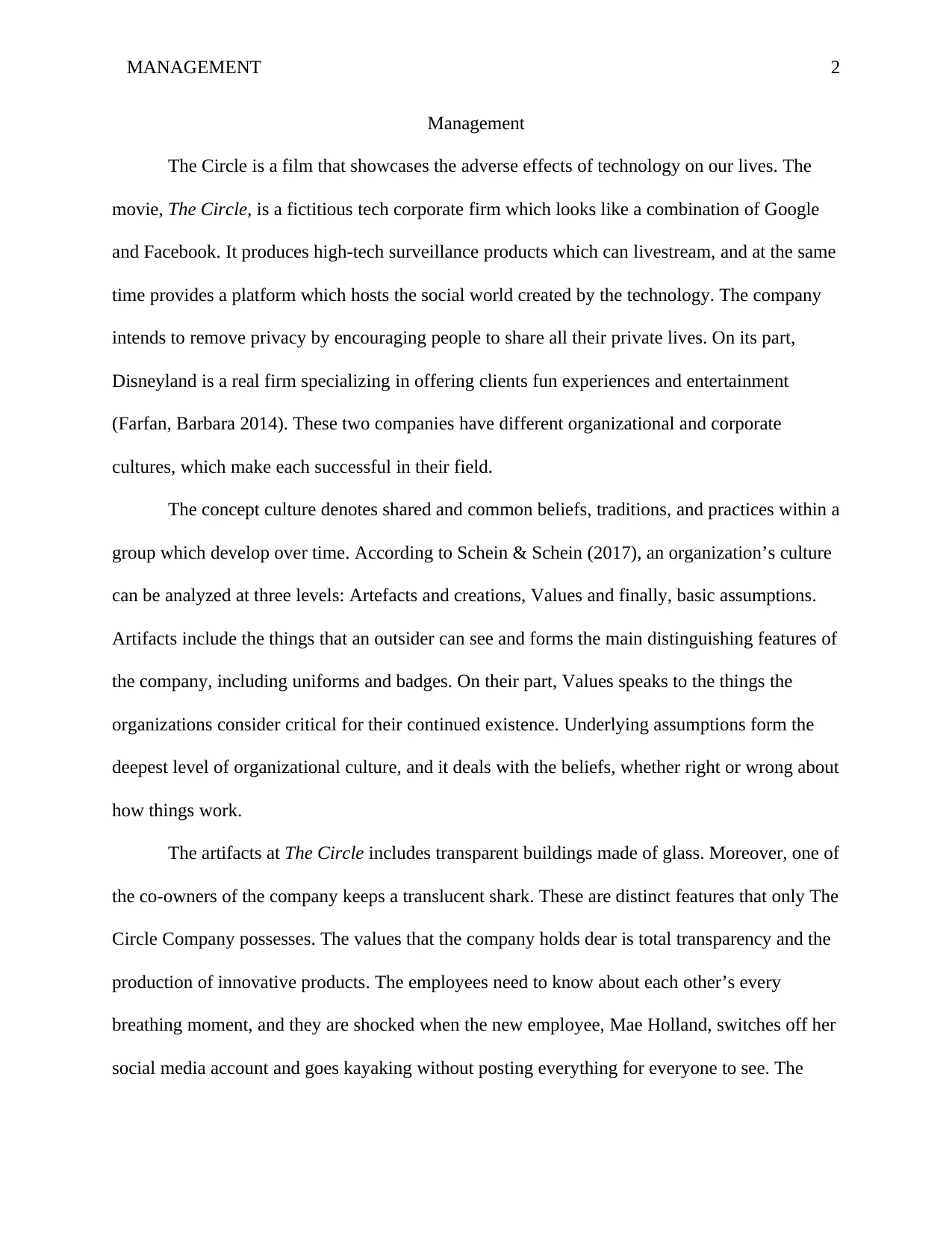
MANAGEMENT 2
Management
The Circle is a film that showcases the adverse effects of technology on our lives. The
movie, The Circle, is a fictitious tech corporate firm which looks like a combination of Google
and Facebook. It produces high-tech surveillance products which can livestream, and at the same
time provides a platform which hosts the social world created by the technology. The company
intends to remove privacy by encouraging people to share all their private lives. On its part,
Disneyland is a real firm specializing in offering clients fun experiences and entertainment
(Farfan, Barbara 2014). These two companies have different organizational and corporate
cultures, which make each successful in their field.
The concept culture denotes shared and common beliefs, traditions, and practices within a
group which develop over time. According to Schein & Schein (2017), an organization’s culture
can be analyzed at three levels: Artefacts and creations, Values and finally, basic assumptions.
Artifacts include the things that an outsider can see and forms the main distinguishing features of
the company, including uniforms and badges. On their part, Values speaks to the things the
organizations consider critical for their continued existence. Underlying assumptions form the
deepest level of organizational culture, and it deals with the beliefs, whether right or wrong about
how things work.
The artifacts at The Circle includes transparent buildings made of glass. Moreover, one of
the co-owners of the company keeps a translucent shark. These are distinct features that only The
Circle Company possesses. The values that the company holds dear is total transparency and the
production of innovative products. The employees need to know about each other’s every
breathing moment, and they are shocked when the new employee, Mae Holland, switches off her
social media account and goes kayaking without posting everything for everyone to see. The
Management
The Circle is a film that showcases the adverse effects of technology on our lives. The
movie, The Circle, is a fictitious tech corporate firm which looks like a combination of Google
and Facebook. It produces high-tech surveillance products which can livestream, and at the same
time provides a platform which hosts the social world created by the technology. The company
intends to remove privacy by encouraging people to share all their private lives. On its part,
Disneyland is a real firm specializing in offering clients fun experiences and entertainment
(Farfan, Barbara 2014). These two companies have different organizational and corporate
cultures, which make each successful in their field.
The concept culture denotes shared and common beliefs, traditions, and practices within a
group which develop over time. According to Schein & Schein (2017), an organization’s culture
can be analyzed at three levels: Artefacts and creations, Values and finally, basic assumptions.
Artifacts include the things that an outsider can see and forms the main distinguishing features of
the company, including uniforms and badges. On their part, Values speaks to the things the
organizations consider critical for their continued existence. Underlying assumptions form the
deepest level of organizational culture, and it deals with the beliefs, whether right or wrong about
how things work.
The artifacts at The Circle includes transparent buildings made of glass. Moreover, one of
the co-owners of the company keeps a translucent shark. These are distinct features that only The
Circle Company possesses. The values that the company holds dear is total transparency and the
production of innovative products. The employees need to know about each other’s every
breathing moment, and they are shocked when the new employee, Mae Holland, switches off her
social media account and goes kayaking without posting everything for everyone to see. The
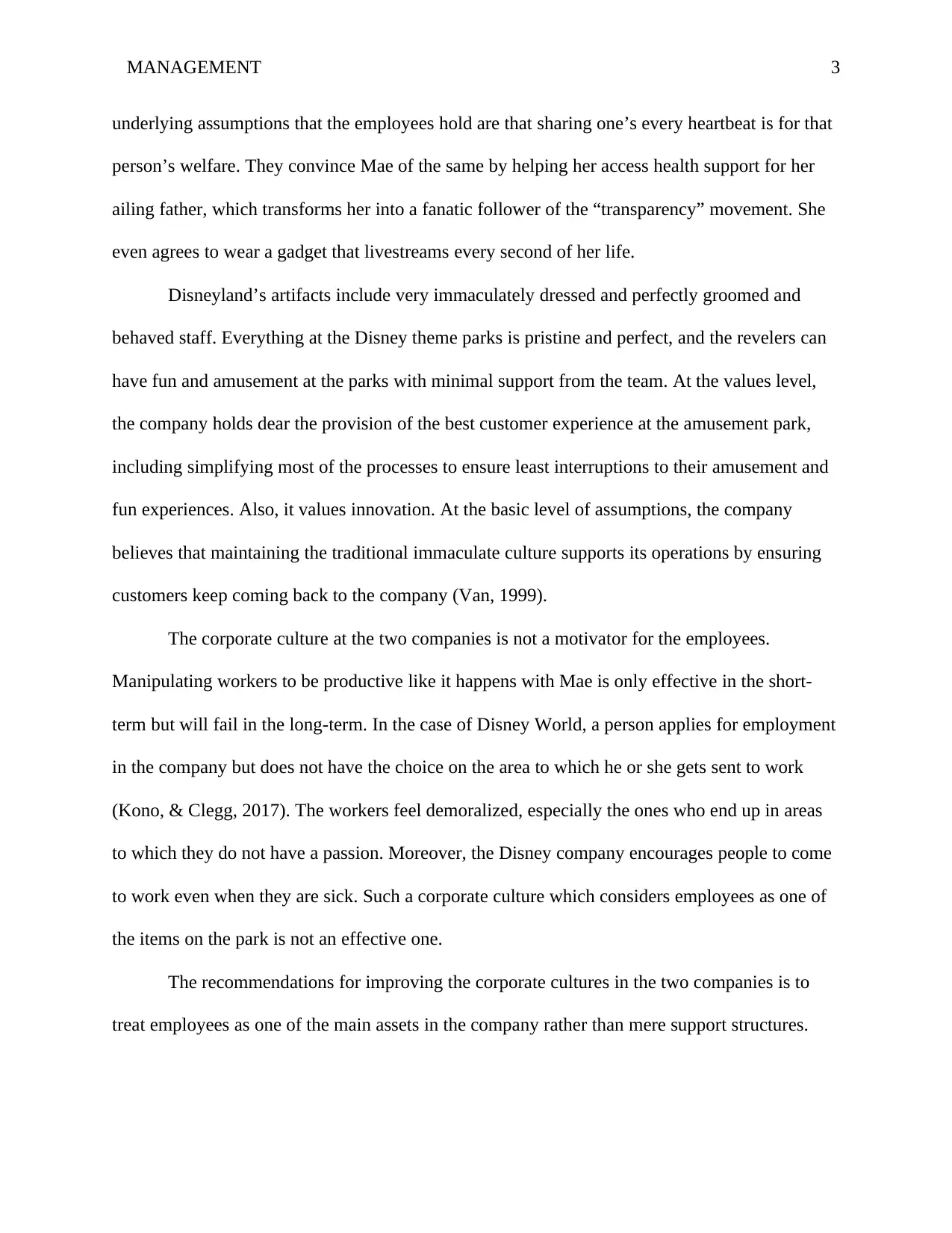
MANAGEMENT 3
underlying assumptions that the employees hold are that sharing one’s every heartbeat is for that
person’s welfare. They convince Mae of the same by helping her access health support for her
ailing father, which transforms her into a fanatic follower of the “transparency” movement. She
even agrees to wear a gadget that livestreams every second of her life.
Disneyland’s artifacts include very immaculately dressed and perfectly groomed and
behaved staff. Everything at the Disney theme parks is pristine and perfect, and the revelers can
have fun and amusement at the parks with minimal support from the team. At the values level,
the company holds dear the provision of the best customer experience at the amusement park,
including simplifying most of the processes to ensure least interruptions to their amusement and
fun experiences. Also, it values innovation. At the basic level of assumptions, the company
believes that maintaining the traditional immaculate culture supports its operations by ensuring
customers keep coming back to the company (Van, 1999).
The corporate culture at the two companies is not a motivator for the employees.
Manipulating workers to be productive like it happens with Mae is only effective in the short-
term but will fail in the long-term. In the case of Disney World, a person applies for employment
in the company but does not have the choice on the area to which he or she gets sent to work
(Kono, & Clegg, 2017). The workers feel demoralized, especially the ones who end up in areas
to which they do not have a passion. Moreover, the Disney company encourages people to come
to work even when they are sick. Such a corporate culture which considers employees as one of
the items on the park is not an effective one.
The recommendations for improving the corporate cultures in the two companies is to
treat employees as one of the main assets in the company rather than mere support structures.
underlying assumptions that the employees hold are that sharing one’s every heartbeat is for that
person’s welfare. They convince Mae of the same by helping her access health support for her
ailing father, which transforms her into a fanatic follower of the “transparency” movement. She
even agrees to wear a gadget that livestreams every second of her life.
Disneyland’s artifacts include very immaculately dressed and perfectly groomed and
behaved staff. Everything at the Disney theme parks is pristine and perfect, and the revelers can
have fun and amusement at the parks with minimal support from the team. At the values level,
the company holds dear the provision of the best customer experience at the amusement park,
including simplifying most of the processes to ensure least interruptions to their amusement and
fun experiences. Also, it values innovation. At the basic level of assumptions, the company
believes that maintaining the traditional immaculate culture supports its operations by ensuring
customers keep coming back to the company (Van, 1999).
The corporate culture at the two companies is not a motivator for the employees.
Manipulating workers to be productive like it happens with Mae is only effective in the short-
term but will fail in the long-term. In the case of Disney World, a person applies for employment
in the company but does not have the choice on the area to which he or she gets sent to work
(Kono, & Clegg, 2017). The workers feel demoralized, especially the ones who end up in areas
to which they do not have a passion. Moreover, the Disney company encourages people to come
to work even when they are sick. Such a corporate culture which considers employees as one of
the items on the park is not an effective one.
The recommendations for improving the corporate cultures in the two companies is to
treat employees as one of the main assets in the company rather than mere support structures.
⊘ This is a preview!⊘
Do you want full access?
Subscribe today to unlock all pages.

Trusted by 1+ million students worldwide
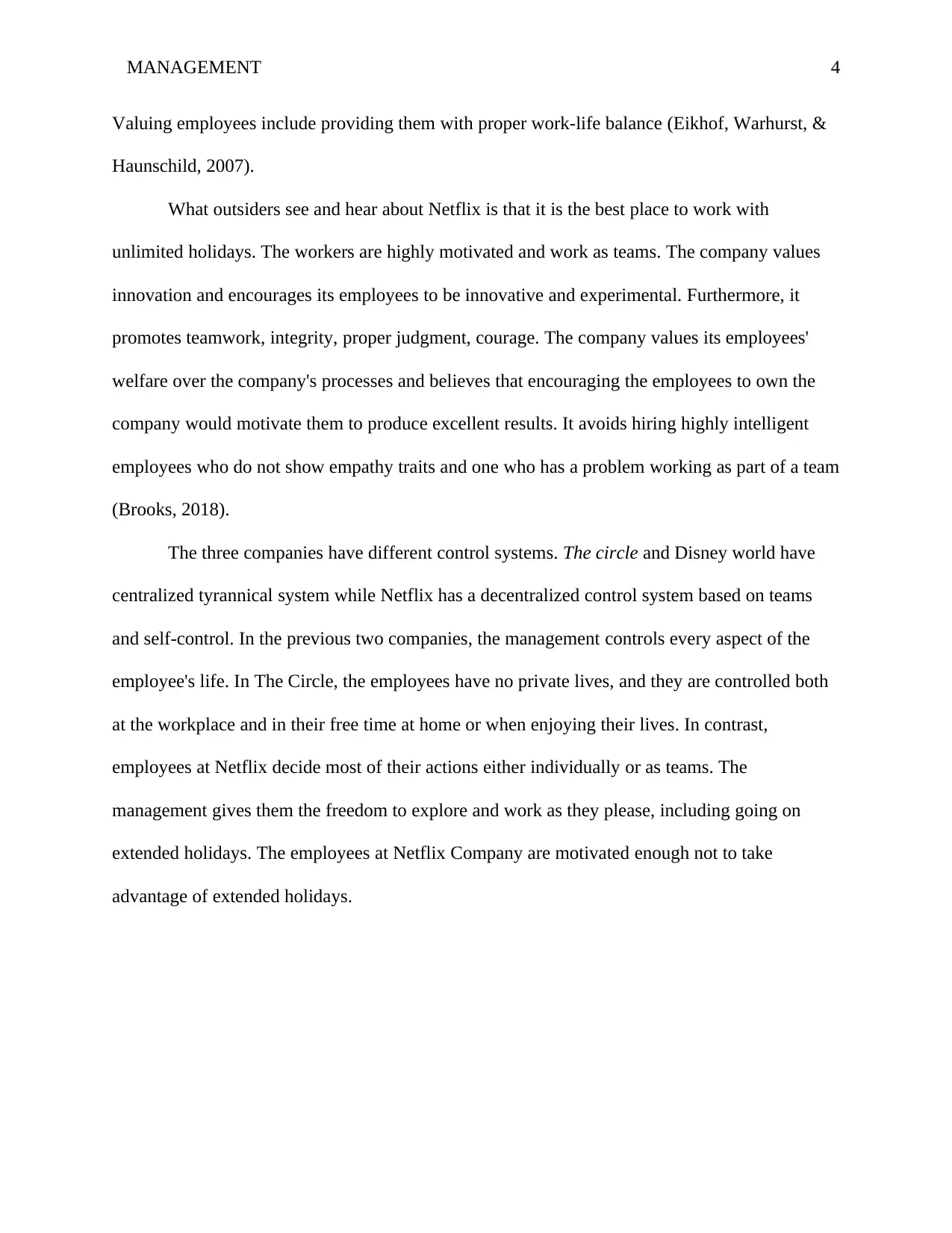
MANAGEMENT 4
Valuing employees include providing them with proper work-life balance (Eikhof, Warhurst, &
Haunschild, 2007).
What outsiders see and hear about Netflix is that it is the best place to work with
unlimited holidays. The workers are highly motivated and work as teams. The company values
innovation and encourages its employees to be innovative and experimental. Furthermore, it
promotes teamwork, integrity, proper judgment, courage. The company values its employees'
welfare over the company's processes and believes that encouraging the employees to own the
company would motivate them to produce excellent results. It avoids hiring highly intelligent
employees who do not show empathy traits and one who has a problem working as part of a team
(Brooks, 2018).
The three companies have different control systems. The circle and Disney world have
centralized tyrannical system while Netflix has a decentralized control system based on teams
and self-control. In the previous two companies, the management controls every aspect of the
employee's life. In The Circle, the employees have no private lives, and they are controlled both
at the workplace and in their free time at home or when enjoying their lives. In contrast,
employees at Netflix decide most of their actions either individually or as teams. The
management gives them the freedom to explore and work as they please, including going on
extended holidays. The employees at Netflix Company are motivated enough not to take
advantage of extended holidays.
Valuing employees include providing them with proper work-life balance (Eikhof, Warhurst, &
Haunschild, 2007).
What outsiders see and hear about Netflix is that it is the best place to work with
unlimited holidays. The workers are highly motivated and work as teams. The company values
innovation and encourages its employees to be innovative and experimental. Furthermore, it
promotes teamwork, integrity, proper judgment, courage. The company values its employees'
welfare over the company's processes and believes that encouraging the employees to own the
company would motivate them to produce excellent results. It avoids hiring highly intelligent
employees who do not show empathy traits and one who has a problem working as part of a team
(Brooks, 2018).
The three companies have different control systems. The circle and Disney world have
centralized tyrannical system while Netflix has a decentralized control system based on teams
and self-control. In the previous two companies, the management controls every aspect of the
employee's life. In The Circle, the employees have no private lives, and they are controlled both
at the workplace and in their free time at home or when enjoying their lives. In contrast,
employees at Netflix decide most of their actions either individually or as teams. The
management gives them the freedom to explore and work as they please, including going on
extended holidays. The employees at Netflix Company are motivated enough not to take
advantage of extended holidays.
Paraphrase This Document
Need a fresh take? Get an instant paraphrase of this document with our AI Paraphraser
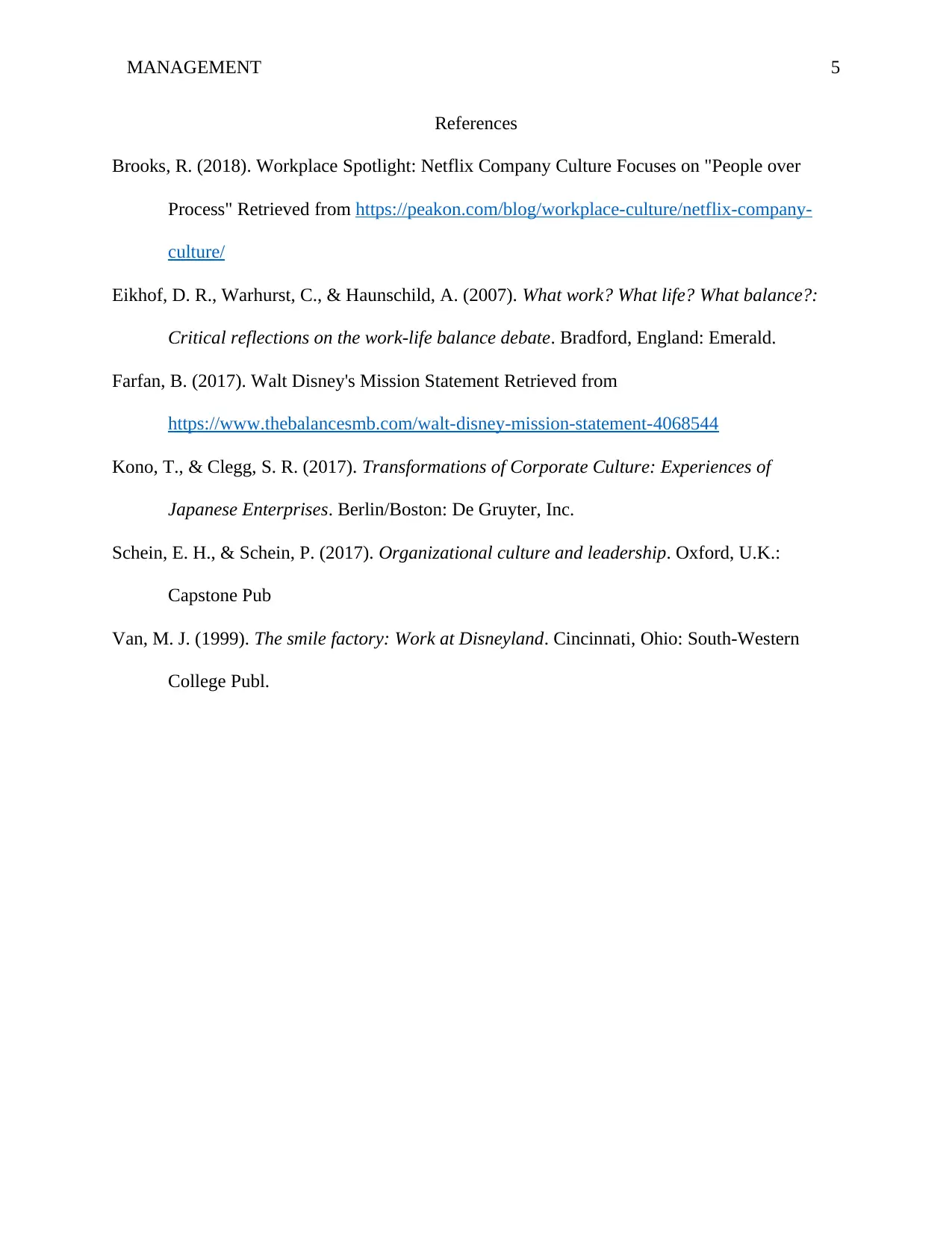
MANAGEMENT 5
References
Brooks, R. (2018). Workplace Spotlight: Netflix Company Culture Focuses on "People over
Process" Retrieved from https://peakon.com/blog/workplace-culture/netflix-company-
culture/
Eikhof, D. R., Warhurst, C., & Haunschild, A. (2007). What work? What life? What balance?:
Critical reflections on the work-life balance debate. Bradford, England: Emerald.
Farfan, B. (2017). Walt Disney's Mission Statement Retrieved from
https://www.thebalancesmb.com/walt-disney-mission-statement-4068544
Kono, T., & Clegg, S. R. (2017). Transformations of Corporate Culture: Experiences of
Japanese Enterprises. Berlin/Boston: De Gruyter, Inc.
Schein, E. H., & Schein, P. (2017). Organizational culture and leadership. Oxford, U.K.:
Capstone Pub
Van, M. J. (1999). The smile factory: Work at Disneyland. Cincinnati, Ohio: South-Western
College Publ.
References
Brooks, R. (2018). Workplace Spotlight: Netflix Company Culture Focuses on "People over
Process" Retrieved from https://peakon.com/blog/workplace-culture/netflix-company-
culture/
Eikhof, D. R., Warhurst, C., & Haunschild, A. (2007). What work? What life? What balance?:
Critical reflections on the work-life balance debate. Bradford, England: Emerald.
Farfan, B. (2017). Walt Disney's Mission Statement Retrieved from
https://www.thebalancesmb.com/walt-disney-mission-statement-4068544
Kono, T., & Clegg, S. R. (2017). Transformations of Corporate Culture: Experiences of
Japanese Enterprises. Berlin/Boston: De Gruyter, Inc.
Schein, E. H., & Schein, P. (2017). Organizational culture and leadership. Oxford, U.K.:
Capstone Pub
Van, M. J. (1999). The smile factory: Work at Disneyland. Cincinnati, Ohio: South-Western
College Publ.
1 out of 5
Your All-in-One AI-Powered Toolkit for Academic Success.
+13062052269
info@desklib.com
Available 24*7 on WhatsApp / Email
![[object Object]](/_next/static/media/star-bottom.7253800d.svg)
Unlock your academic potential
Copyright © 2020–2025 A2Z Services. All Rights Reserved. Developed and managed by ZUCOL.